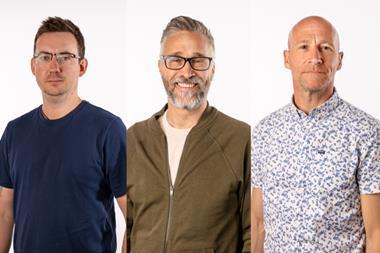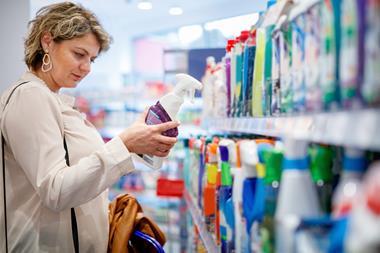Chris de Lapuente talks to James Durston about the building blocks of P&G's rapid growth: research, innovation and trust
Chris de Lapuente has done eight interviews already today and he looks tired. As president of Procter & Gamble's global haircare division, it's his job not only to oversee its burgeoning haircare empire, but also to promote it when required - and he's not really the PR type.
Then the subject of P&G's growth crops up - beauty sales have gone from $1bn (£571m) 20 years ago to $20bn today - and he springs to life, giving a glimpse of why this 43-year-old has risen through the ranks to head up the world's leading haircare business.
He says: "Over the past three years our health and beauty division has had double-digit volume, sales and profit growth. We're on track this year to deliver 10% sales growth and 12% earnings growth, and our mid-tier businesses have grown 50% over the past three years."
You could forgive de Lapuente a smile as he rolls off those impressive numbers, but he remains matter of fact. After two years in the role, following six years as P&G's vice president and general manager for UK and Ireland, he has learnt that satisfaction can lead to complacency. His ambition is nothing less than you would expect from a business like P&G: "We want to serve all six billion people around the world."
So how exactly is he going to do that?
There are two areas where P&G can significantly increase its haircare presence: male grooming and emerging markets. The first has room for something really big off the back of the $54bn acquisition of Gillette last year, the biggest in P&G's history, he says. "We're only just starting to learn about male grooming, but we know it's growing fast. The Gillette acquisition opens up the possibility of a haircare product for men."
It's a proposition that de Lapuente is guarded about, but with Gillette's experience in handling billion-dollar brands (it owns Oral-B, Mach3, Braun, Gillette and Duracell, all of which have sales of $1bn or more) the fit with P&G is a good one. Another male-oriented shampoo would balance the haircare portfolio nicely.
A bigger potential growth area is developing markets, though, and it's here where P&G's strengths in research - it spent close to $2bn last year on R&D - could really be applied effectively. Developing markets represent 23% of P&G's sales currently, but have 86% of the world's population and account for 25% of the world's total GDP.
These lower income consumers are vital to achieving the growth de Lapuente wants. "We're not out to serve the rich. We need to reach low income consumers and build and maintain their trust in our brands. But brands have different roles to play around the world. Some people in the Philippines like high levels of perfume in their shampoo, others in China want shampoo sachets that you can open with wet hands. It's this obsession with knowing our consumers that allows us to nurture and drive our brands effectively."
This research bug has got it into trouble in the past. P&G admitted to spying on Unilever's haircare business in 2001, for which it had to compensate Unilever. But it's this attention to detail that wins customers, shrugs de Lapuente. Indeed, for a category notorious for lacking consumer loyalty, P&G owns some consistently high-selling products. Pantene and Head & Shoulders, the world's number one and two shampoo brands respectively, have combined sales of $4bn. Total haircare sales contribute $10bn of P&G's total $56.7bn turnover, which is 24% of the global haircare market, and the plan is to continue adding to the portfolio with new products.
That $2bn in R&D comes in useful here. "It's such a competitive industry, innovation is fast and furious, so we need to make sure we're on top of our game."
This ethos spreads through all three of the company's global business units (beauty, household care, family health) and the lack of internal barriers can help push things along. "Insights in fabric care have been transferred to beauty," says de Lapuente. "Our fabric researchers found ways to gently keep colour and liveliness in clothes, for example. This knowledge has been used for the same results in a Pantene product."
But P&G is about much more than shampoo and one of its strengths is that it is able to camouflage itself with a variety of brands, such as Olay face creams, Pampers nappies and Crest toothpaste. This helps in an age when society tends to demonise the big and successful. It also helps when you're the target of animal rights groups, as P&G frequently is. "A large corporation will always attract the attention of interest groups, but we're just trying to make everyday life a bit better for our consumers. As long as we innovate we will continue to grow."
Perfumes are going to be particularly big for P&G in the next few years, as its partnership with fashion houses such as Valentino shows. Research indicates that men tend to put their aftershave on their wrists. This has led to an aftershave with a top note that is reactivated after contact with water, so when the wearer goes to wash his hands he gets a new wave of his favourite smell.
This is what it's all about, says de Lapuente: reaching into the consumer psyche and giving it what it wants. "At the end of the day it comes down to whether you deliver well. Can the consumer trust your brand?"
It'll take a lot of work to build that trust in six billion people, but with P&G's commitment to advertising - it spent $5.9bn last year - who's to say it isn't possible?
Q&A
Chris de Lapuente has done eight interviews already today and he looks tired. As president of Procter & Gamble's global haircare division, it's his job not only to oversee its burgeoning haircare empire, but also to promote it when required - and he's not really the PR type.
Then the subject of P&G's growth crops up - beauty sales have gone from $1bn (£571m) 20 years ago to $20bn today - and he springs to life, giving a glimpse of why this 43-year-old has risen through the ranks to head up the world's leading haircare business.
He says: "Over the past three years our health and beauty division has had double-digit volume, sales and profit growth. We're on track this year to deliver 10% sales growth and 12% earnings growth, and our mid-tier businesses have grown 50% over the past three years."
You could forgive de Lapuente a smile as he rolls off those impressive numbers, but he remains matter of fact. After two years in the role, following six years as P&G's vice president and general manager for UK and Ireland, he has learnt that satisfaction can lead to complacency. His ambition is nothing less than you would expect from a business like P&G: "We want to serve all six billion people around the world."
So how exactly is he going to do that?
There are two areas where P&G can significantly increase its haircare presence: male grooming and emerging markets. The first has room for something really big off the back of the $54bn acquisition of Gillette last year, the biggest in P&G's history, he says. "We're only just starting to learn about male grooming, but we know it's growing fast. The Gillette acquisition opens up the possibility of a haircare product for men."
It's a proposition that de Lapuente is guarded about, but with Gillette's experience in handling billion-dollar brands (it owns Oral-B, Mach3, Braun, Gillette and Duracell, all of which have sales of $1bn or more) the fit with P&G is a good one. Another male-oriented shampoo would balance the haircare portfolio nicely.
A bigger potential growth area is developing markets, though, and it's here where P&G's strengths in research - it spent close to $2bn last year on R&D - could really be applied effectively. Developing markets represent 23% of P&G's sales currently, but have 86% of the world's population and account for 25% of the world's total GDP.
These lower income consumers are vital to achieving the growth de Lapuente wants. "We're not out to serve the rich. We need to reach low income consumers and build and maintain their trust in our brands. But brands have different roles to play around the world. Some people in the Philippines like high levels of perfume in their shampoo, others in China want shampoo sachets that you can open with wet hands. It's this obsession with knowing our consumers that allows us to nurture and drive our brands effectively."
This research bug has got it into trouble in the past. P&G admitted to spying on Unilever's haircare business in 2001, for which it had to compensate Unilever. But it's this attention to detail that wins customers, shrugs de Lapuente. Indeed, for a category notorious for lacking consumer loyalty, P&G owns some consistently high-selling products. Pantene and Head & Shoulders, the world's number one and two shampoo brands respectively, have combined sales of $4bn. Total haircare sales contribute $10bn of P&G's total $56.7bn turnover, which is 24% of the global haircare market, and the plan is to continue adding to the portfolio with new products.
That $2bn in R&D comes in useful here. "It's such a competitive industry, innovation is fast and furious, so we need to make sure we're on top of our game."
This ethos spreads through all three of the company's global business units (beauty, household care, family health) and the lack of internal barriers can help push things along. "Insights in fabric care have been transferred to beauty," says de Lapuente. "Our fabric researchers found ways to gently keep colour and liveliness in clothes, for example. This knowledge has been used for the same results in a Pantene product."
But P&G is about much more than shampoo and one of its strengths is that it is able to camouflage itself with a variety of brands, such as Olay face creams, Pampers nappies and Crest toothpaste. This helps in an age when society tends to demonise the big and successful. It also helps when you're the target of animal rights groups, as P&G frequently is. "A large corporation will always attract the attention of interest groups, but we're just trying to make everyday life a bit better for our consumers. As long as we innovate we will continue to grow."
Perfumes are going to be particularly big for P&G in the next few years, as its partnership with fashion houses such as Valentino shows. Research indicates that men tend to put their aftershave on their wrists. This has led to an aftershave with a top note that is reactivated after contact with water, so when the wearer goes to wash his hands he gets a new wave of his favourite smell.
This is what it's all about, says de Lapuente: reaching into the consumer psyche and giving it what it wants. "At the end of the day it comes down to whether you deliver well. Can the consumer trust your brand?"
It'll take a lot of work to build that trust in six billion people, but with P&G's commitment to advertising - it spent $5.9bn last year - who's to say it isn't possible?
Q&A






No comments yet